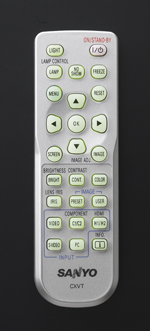Sanyo PLV-Z5 High Definition LCD Home Theater Projector Review
By Joe Lozito
Sany-oh yes!
Faithful Big Picture Big Sound readers will already know that I'm a huge fan of Sanyo home theater projectors. In my personal home theater, I've had, and loved, the Sanyo PLV-Z2 for almost three years. Despite advances in competing home theater projectors, and the relative price drop of 1080p projectors, I've seen no reason to replace my beloved Z2. That is, until now.
The
Sanyo PLV-Z5 is a fantastic step forward in Sanyo's line of projectors, with all the trimmings we're used to from a Sanyo, plus two HDMI inputs, 1080p input support (with internal scaling to the projector's native 1280x720 panel resolution) and a whopping 10,000:1 contrast ratio.
Into the Box
Initially, the Z5 looked less sleek that the Z2. In fact, it looked downright "boxy." Of course, looks aren't everything for a projector. It's what's inside that counts.
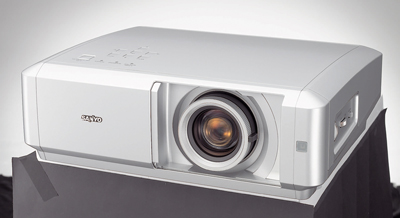
Sanyo's PLV-Z5 720P HD LCD Projector.
Once I installed the Z5 in our QA lab, I couldn't help but think, "Fits like a glove!" I've said it before and I'll say it again:
nobody lens shifts like Sanyo. With a full 150% up/down and 50% left/right, you can put this baby in the corner if need be, and still project a geometrically accurate image with no electronic keystoning required.
As I said in my review of the
Panasonic PT-AX100U, projectors in this class are moving towards a slightly larger size and weight. So, at 11.0 lbs and 5.0 x 15.0 x 12.0 inches, the Z5 is about average.
What makes the Z5 a beauty is its motorized lens cover, which automatically slides open when you power the unit on. The cover keeps the lens out of sight and safely tucked away from ambient dust when the projector is not in use. In the dust-bowl that is New York City, this is a killer feature. I never got sick of hitting the power button and hearing that lens cover slide open. Those of you with an insatiable appetite for media can
see the lens cover in action.
Faithful readers will also remember that I have a pretty sensitive ear when it comes to fan noise. It was almost startling how quiet the Z5's fan was. It's actually even quieter than the Z2, and noticeably quieter than the Panasonic.
Note: the review model we used had a high-pitched whine when the projector powered on which continued for about an hour or two. This noise was most likely due to the review model having been "around the block" a few times. Sanyo is checking it out for us. It's not likely this would occur with a new production model
So, now that the Z5 had turned me on, I couldn't wait to return the favor.
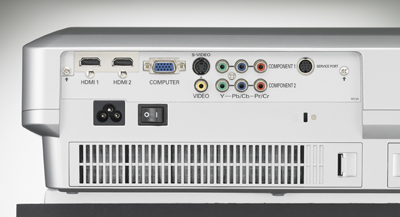
Multiple inputs is an understatement.
Cali-forni-bration
Before getting my calibration on, I played around with the factory presets, just for fun. I marveled at the wacky "Dynamic" and "Vivid" settings, the latter of which the manual says is "for viewing contrasty images to a maximum extent." The "Natural" setting was appropriately bland, but I felt like Goldilocks choosing from the trio of Cinema settings: Brilliant Cinema ("too bright"), Pure Cinema ("too dark"), Creative Cinema ("just right"). In reality, of course, none of the settings really did justice to the Z5 which comes with an Image Adjustment Advanced Menu which allows for very detailed calibration.
So enough about the presets, let's get down to business. I started by zero'ing out all the settings (Brightness, Contrast, etc) and working with the AVIA Guide to Home Theater DVD. The AVIA disc is always helpful for some minor configuration, but I find the RGB settings difficult to eyeball with AVIA. I ran through AVIA twice and came up with very similar settings, but in both cases the flesh tones were noticeably too red. It could be that the Z5 has
too many settings for the fairly rudimentary AVIA disc. For example, there are
four sets of RGB settings (cuts, gains, gamma and balance).
For reference, RGB Gain is Contrast and RGB Offset is Brightness.
I'm Seeing Red (and Green and Blue)
I decided to leave the heavy-duty calibration up to
Spyder TV Pro, and here's where the real fun started. Again, I zero'd out all the settings, taking special note of the "Color Temp" setting. The Z5 comes with five Color Temp presets (LOW3, LOW2, LOW1, MID and HIGH). If you change those RGB settings at all in the advanced menus, the Z5's Color Temp will change to a setting called "USER."
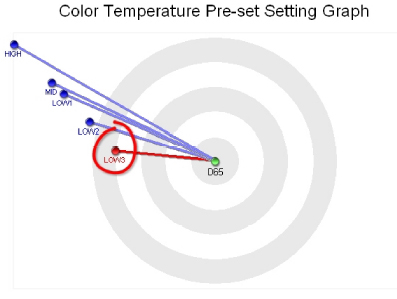
Of the presets, "LOW3" measured closest to NTSC standard 6500 degrees.
During the calibration process, SpyderTV measures all of the various color temperature presets and reports back on which is the most accurate - in this case "LOW3." As the chart shows, this setting puts the projector's white level the closest to NTSC standard 6500 degrees - not as close as some presets we've seen on other displays, but close enough to produce decent whites and realistic colors. With RGB level tweaking, this accuracy improved further.
The first time, I continued with the calibration using LOW3, the second time, I went back and zero'd it back to USER. In each case I got a slightly different outcome, but I found LOW3 (with custom RGB adjustments) gave me the best results. As I mentioned, the Z5 allows for so many combinations of Rs, Gs and Bs, that I could have spent weeks in those menus.
Once I was finished with all my calibrations, I had filled all four of the Z5's user image settings (two were AVIA tests and two were SpyderTV tests). The most accurate of these (to my eyes) was the one where we used the "LOW3" preset as a basis, then tweaked the RGB cuts and gains in the advanced menu. I was impressed, even during casual viewing, at the Z5's image quality. The color depth was beautiful and the black levels had a richness I had seen before only on the Panasonic projectors. So now it was time to put it to the test by viewing something other than test patterns.

Woohoo! All 100s! The Sanyo's RGB levels in reproducing high and low shades of grey were picture perfect.
Who Watches Standard Def Content Anymore?
OK, I guess we all do. Before really putting the Z5 through its paces, I had to see what standard-definition content looked like. This is always an interesting test for a high-def projector. We videophiles don't setup home theaters to watch Comedy Central in SD. And yet, invariably, we will be forced to watch that muddy 4:3 picture on occasion, so it's important that the picture is at least passable.
Here the Z5 didn't disappoint. Flipping through several standard Cable channels was no worse than the Z2 and, in fact, looked a bit cleaner. That may have been due to the superior configuration of the Z5, but regardless I'd be happy to watch regular TV with this picture.
Moving on to standard DVDs was equally satisfying. I started with a couple of old favorites:
"King Kong" (T-Rex fight),
"Batman Begins" (Gotham Cityscape),
"Superman Returns" (airplane rescue) and, of course, "The Fifth Element" (Milla's first appearance). The danger of throwing on these movies with a projector as good as the Z5 is that it's very easy to get sucked into watching the whole thing. It's hypnotic.
But I had ulterior motives for choosing these titles as well - I had HD versions of most of them, as you'll soon see.
In terms of real torture tests on SD material, we used the HQV Benchmark DVD (connected at 480i resolution) to test the Sanyo's internal video processor and scaler. As a reference, we first ran the tests on the new Toshiba HD-XA2 HD-DVD player, with its output set to 720p - the native resolution of the Sanyo projector. The HD-XA2 ($999) is Toshiba's new top of the line HD-DVD player which includes Silicon Optix' Reon-VX chip set - one of the best video processors on the market.
As expected, the Toshiba player's internal scaler and video processor produced exceptional results, passing the "jaggies" tests (interlacing) with flying colors. Diagonal lines remained smooth at virtually any angle, and the waving flag test looked crisp and smooth. The player also locked on immediately to a 3:2 film sequence producing sharp, stable details in the race track test sequence.
Switching over to the Sanyo's processor (setting the Toshiba player's output to 480i) highlighted the difference between a very good video processor and an outstanding one. The Sanyo had a little more trouble producing smooth diagonal line in the "jaggies" tests at the shallowest angles. The flag test did exhibit some rough edges, and the Sanyo had some trouble locking to the 3:2 sequence in the race track test. Certainly not the worst we've seen, but not in the same league as the top of the line Toshiba player.
The Sanyo performed admirably in other tests, including its handling of video noise, detail tests and mixed video/film content. For best results, however, we'd recommend using a high-end upconverting DVD player, such as the Toshiba, or players by Denon and Oppo, when watching standard DVDs on the Sanyo. But we're much more interested in the Sanyo's performance on HD material so...
Putting the Super Back in the Super Bowl
As luck would have it, the Z5 arrived for review just in time for the Super Bowl. Now, initially, I was planning on starting the review after Super Bowl weekend - but how could I pass up the opportunity to watch the big game in all its high-def brilliance?
As far as first impressions goes, this was a beaut. CBS-HD broadcasts at 1080i and, checking the Z5's information menu, that's the signal it was receiving. The image quality was mind-blowing. Those of you who saw the game know that there was a fairly torrential rainstorm throughout. The Z5's picture was so good, I almost put a tarp under my screen to protect my floor. No, really.
But enough about the Super Bowl, let's see some HD movies on this puppy. I lined up Toshiba's vastly improved HD-XA2 HD-DVD player and a PlayStation 3 for HD-DVD and Blu-Ray content respectively. Naturally, I set both players to 1080p display output to see what the Z5 could do with it. While the image was excellent on 1080p (the Z5's signal information read "D-1080p"), since 720p is the Z5's native resolution I didn't see much difference between a 1080p and a 720p output setting on these players. This is to say that the Toshiba player, the Sony PS3 and the Sanyo projector were all pretty equal at scaling the native 1080p content on these movies to the 1280x720 native panel resolution of the projector.
The HD "Batman Begins" disc had a stunning depth of field and the blacks were perfect for that film. The Blu-Ray "Fifth Element" disc isn't the best transfer in the world, so the image was only a minor improvement over SD DVD, but a noticeable one. The PS3's HD games, however, brought the house down. As an FYI, some descriptions of the image quality from our testing crew were: "f—ked up good" and "retarded good," for what that's worth. The racing games in particular almost gave us motion sickness.
It's worth noting that the Z5 also vastly improves on the clarity of PC projection over earlier Sanyo projectors. Though it no longer has the DVI input of the Z2, the image displayed through the VGA input was vastly superior to the Z2 (note, the PC's resolution was set to 1280x1024 for this test). If your PC's video card only has a DVI-D output, then you can simply use a DVI-D to HDMI cable to keep the signal in the digital domain.
I was also happy to see that the Z5 comes with a small "turkey baster" for cleaning dust - something I could have used for the Z2.
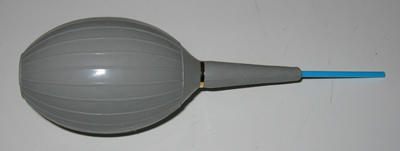
Thanksgiving must be coming.
In Perfect Harmony
The Z5's remote is typically easy-to-use, with quick access to the Brightness, Contrast, Color and Preset settings (which makes for quick calibration, thank you Sanyo). And I was very happy to see that the Z5 worked with my Z2-configured
Logitech Harmony 890 with no changes (though for some reason the component1 input on the Z2 brings up component2 on the Z5 - I can live with that).
Final Thoughts
With an estimated "street price" of well under $2,000, the Z5 is a can't-miss for any home theater enthusiast, or really anyone who enjoys watching movies and high definition television in the comfort of their own home. The Sanyo gives you a winning combination of outstanding picture quality, excellent ergonomics and enormous picture size. Although we have seen better results in the conversion of SD video sources to HD, the exceptional performance of the Sanyo projector with native high definition material more than makes up for this to earn our highest ratings across the board. Highly recommended.
Where to Buy:
•
Sanyo PLV-Z5 LCD projector on B&H ($1094 as of 10/17/07)
•
Sanyo PLV-Z5 LCD projector on TigerDirect
Specifications from the Manufacturer
• Brightness (Lumens): 1100 ANSI
• Contrast: 10000:1
• MSRP: $1995
• Weight: 11.0 lbs.
• Size (inches) (HxWxD): 5.0 x 15.0 x 12.0
• Zoom: Manual, 2.00:1
• Throw Dist (feet): 8.1 - 30.2
• Image Size (inches): 40.0 - 300.0
• Keystone Correction: Digital
• Lens Shift: Horizontal + Vertical
• Warranty: 3 Years
Compatibility:
• HDTV: 720p, 1080i, 1080p/60,1080p/50
• EDTV/480p: Yes
• SDTV/480i: Yes
• Component Video: Yes
• Composite Video: Yes
• Digital Input: HDMI (HDCP)
• Personal Computers: Yes (VGA D-sub-15)
Manufacturer's Contact Information
Sanyo Fisher Company
21605 Plummer Street
Chatsworth, CA 91311
website:
www.sanyo.com





